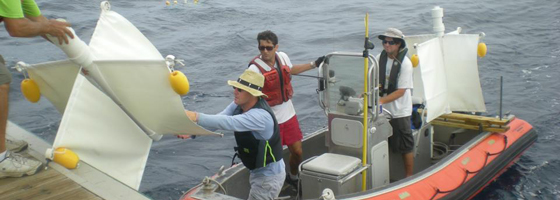Largest drifter project ever improves oil movement forecasts in the Gulf of Mexico

A research consortium formed after the Deepwater Horizon oil spill has deployed more than 300 water drifters near the rig’s explosion site to better oil movement forecasts in the Gulf of Mexico. Known as the Grand Lagrangian deployment, it is the largest of its kind in history.
By logging the drifters’ locations as they move, scientists have gained insights into the effects sea currents have on the transport of crude oil. The data, collection of which began in July 2012, will help emergency planning and improve forecasts of the pollutant’s movement in future oceanic disasters.
The Consortium for Advanced Research on Transport of Hydrocarbon in the Environment (CARTHE) won funding for the project from the Gulf of Mexico Research Initiative. The research initiative was founded through an agreement between the Gulf of Mexico Alliance and BP to provide $500 million in funding for independent scientific research related to the Deepwater Horizon incident over the course of 10 years.
“We are a modeling group and we want to make a forecasting system that is suitable for pollution transport,” said Dr. Tamay Ozgokmen, director of CARTHE and professor at the University of Miami. “The cheapest, most ecological way to do that is through surface drifters.”
The project began with help from the U.S. Coast Guard, which has routinely used data from drifters in search and rescue missions. The Coast Guard agreed to drop a few drifters into the Gulf in exchange for use of the experiment’s data when it was fully up and running.
“We made an agreement with the Coast Guard to release four by air to get a sense of circulation before the mass deployment,” said Ozgokmen. “Then we released 24 around Deepwater Horizon and about 90 each day at different sites. Most of the deployments took place in three days.
“We made data available immediately to the U.S. Coast Guard. They used it the whole time for test missions and whenever Hurricane Isaac hit. They saw ours and needed to deploy fewer of their own. They put theirs where there were gaps,” said Ozgokmen.
In all, 317 drifters were placed into the Gulf, each one about three feet tall with floats and support screens that keep each GPS unit stable and vertical. Ozgokmen says a typical research project would only need 10 to 20 drifters.

The GPS transmitters relay the coordinates of each drifter to a satellite, which provides updates to researchers every five minutes. That transmission frequency made it possible for them to find more variations between data points.
“The current model is not very good. This is an area where satellite forecasts don’t work very well,” said Ozgokmen. “The Earth’s rotation tends to create huge oscillations that keep it going round and round, like a pendulum. Our major goal is now to improve the forecasting system. The data has been unavailable in such large quantities and it takes time.”
The oil industry’s presence in the Gulf also complicates research there.
“You can’t see them on the coast, but you go 10 miles out and there’s a forest of oil rigs. In the middle of nowhere, there’s a city of these things,” said Ozgokmen. “There are 4,000 oil rigs in the Gulf and the companies are digging deeper and deeper.”
He says heat in the Gulf also affects the water currents there and is another consideration to take into account. The Florida Straits were a factor, strong currents which Ozgokmen says only took a few drifters out of the Gulf.
In addition to improving forecast models that can be used by the Coast Guard and emergency responders in future disasters, Ozgokmen says the research is valuable in other ways.
“For me, it’s the biggest project of my career. It’s an emotional project,” said Ozgokmen. “We’re usually running models on computers, but this work is contributing to society. Fisheries will benefit from this work. Students are getting educated. It’s a meaningful research.”
On average, there is one oil spill per year in the world’s oceans. Improved forecasting models could help contain them better. The Naval Research Laboratory will likely use the data to strengthen its models.
As to what happens when a drifter goes offline, Ozgokmen says fishermen find them and send them back to CARTHE. He says CARTHE is working on a prototype drifter that is biologically degradable and about the size of a sushi box. Ten prototypes were tested in the deployment.
“At the current rate, we’ll run out at the end of the year. We’re losing about two drifters every day. Sometimes three, sometimes one, but averaging two each day,” said Ozgokmen.
When transmissions end, CARTHE will begin analyzing the more than five million data points that have been collected.




0 comments